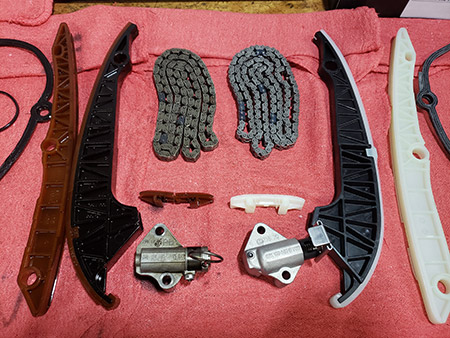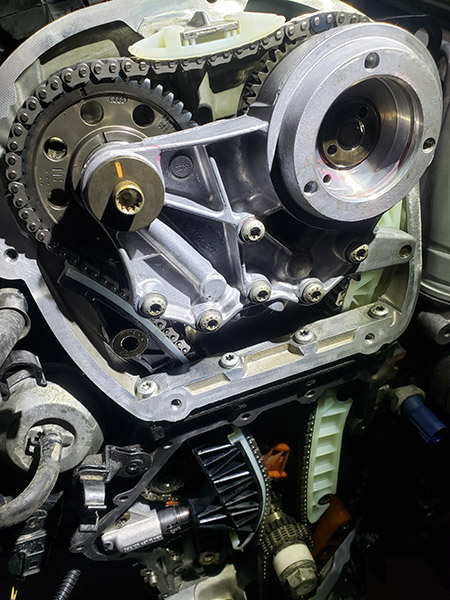Bmw e46 subframe repair / reinforcement
The BMW E46 has been plagued with an unfortunate weak point since its inception into the BWM lineup. The rear axle carrier panel is highly susceptible to cracking and tearing due to several design flaws. From continuous transition between on-off throttle, the panel begins to stress and fatigue due to a pitching movement of the rear subframe. To strengthen the rear subframe mounting points on the rear axle carrier panel, we utilize engineered steel reinforcement plates. These plates are welded to the chassis after any chassis repairs are completed. The plates provide a stronger and larger surface area to better disperse the force generated by the rear subframe and suspension components. Combined with stronger subframe bushings, we provide a sound solution that keeps the rear chassis intact and ready for reliable performance.
Our rear subframe reinforcement service includes the following:
- Full disassembly of the rear assembly
- Degreasing and cleaning of the rear axle carrier panel
- Repair of any minor and common cracks
- Welding in rear subframe reinforcement plates
- Three-stage undercarriage coating to prevent corrosion
- Subframe bushing replacement
- Reassembly of the rear assembly
With the rear assembly removed, there are a number of additional services that can be completed at a lower cost due to overlap in labor with the rear assembly removed.
- Differential bushings and mount
- Outer upper and lower ball joints
- Rear trailing arm bushings
- Upper inner control arm bushing
- Lower control arm
- Rear sway bar

bmw connecting rod bearing replacements
(S54, S65 and S85) - BMW has created and produced some of the greatest naturally aspirated motors available on the road today. Due to these motors high strung and high revving nature, they do need some additional upkeep to assure long term reliability of the powertrain.
The connecting rod bearings are one of the weaker links in the motor that require preventive replacement for increased long term reliability. It is much more ideal and cost effective to tackle this project prior to failure. Once a rod bearing fails and spins, it can compromise the crank or even the whole motor!
We have done full rod bearing replacements on the BMW S54B32, S62B50, S65B40, and S85B50. From our years of experience with these engines, we have assembled comprehensive packages to address this underlying issue.
vanos service, repair / rebuild
Another downfall to a number of BMW models ranging from the mid-nineties to the late 2000’s is the infamous VANOS system. The variable valve timing system, also known as VANOS, has a number of key design flaws that over time can lead to a noisy valve train, leave you stranded in limp mode and even be catastrophic to your motors life.
We offer custom, specially modified VANOS kits for all of the single and dual VANOS equipped BMW's, Euro E36 M3's, E46 M3 and E39 M5. Our VANOS units are professionally rebuilt to a much higher standard than the factory refurbished units and will solve engine performance problems that are due to a malfunctioning or stuck VANOS.
Our standard VANOS service includes the following:
- Full disassembly and cleaning of the original VANOS unit
- New VANOS seals
- New modified pump disk with reduced tolerance
- Anti-rattle kit to reduce noise of operation
- New OE S62 VANOS hub springs
- New OE (updated spec) VANOS hub and gear fasteners
- New OE VANOS filter
- New OE upper chain guide
With the valve cover removed, there are a number of additional services that can be completed at a lower cost due to overlap in labor with the valve cover removed. Please inquire about the following optional services:
- Spark plug replacement
- Valve adjustment (S54 models only)
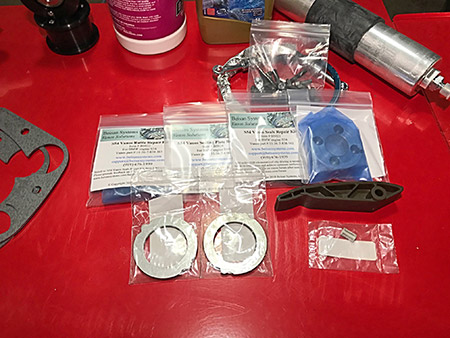
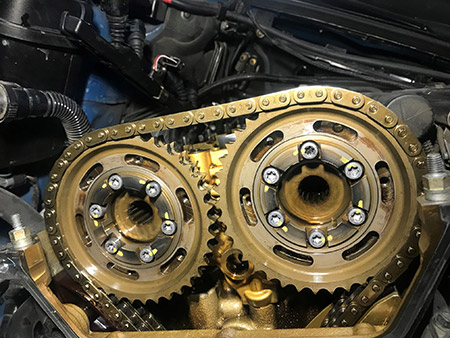
late model Porsche ims bearing
IMS stands for ‘Intermediate Shaft Bearing’, which is the supporting bearing of the intermediate shaft, on the flywheel end of the motor (See red arrow below). The purpose of the intermediate shaft is to drive the camshafts indirectly off the crankshaft. By using an intermediate shaft, the speeds of the chains are reduced, which is better for the chain life.
What Porsche models are prone to IMS failure and should be replaced?
- All 986 Boxster models
- 987 Cayman & Boxster models up to engine number 61504715
- All 996 models (not including GT and Turbo models)
- 997 3.6ltr with M96/05 up to engine number 6950745
In worst-case scenarios, the cam timing can also be thrown off, which causes valve to piston contact. That is considered a catastrophic failure which would require a complete engine replacement.
One thing is for sure; once you have experienced an IMS bearing failure, there is NO turning back. A complete engine disassembly is required to replace the intermediate shaft and in most cases, complete rebuild or engine replacement is your ONLY option.
We’ve been managing the maintenance and serviceability of IMS bearings for quite some time, over the many years we’ve tested a few different solutions and after it all, it’s the LN Engineering IMS Retrofit that is the one for us. By converting the single row of ball bearings to a dual row setup, the Retrofit allows for 90% more load capacity. It is clear to see that the reduced load capacity of the single row IMS bearing is a significant factor to the increased number of failures. That’s why the installation of a dual row ball bearing is the logical evolution for the IMS Retrofit.
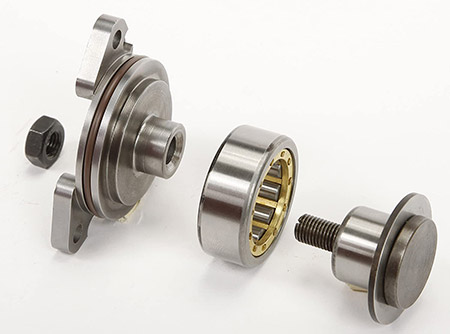
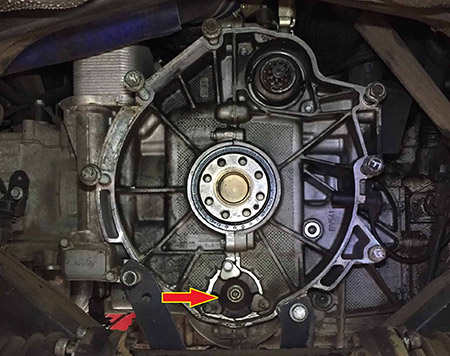
bmw s55 motor crank hub upgrade

The S55 motor that is in the f80 and f82 M3’s and M4’s as well as the M2 competition is an amazing platform to develop. Unfortunately, with power development, a major design flaw in the crankshaft, timing gear and oil gear design can be encountered. The multi piece design paired with the increased power levels that are easily achievable can lead to the clamping force of the assembly being exceeded. This causes the camshaft timing to fall out of sync with the crackshaft causing piston of valve contact in some cases.
Our solution was developed and tested by MaxPSI who currently holds the ¼ mile record with the S55 motor. This keyed solution eliminates the friction washer design that BMW used to affix the crank hub, timing gear, and oil pump gear to the end of the crankshaft. In conjunction with a keyed timing and oil pump gear the hub itself is pinned to the crank shaft similar to many GM motors.
Don’t be afraid to add power to your S55 motor, contact us and add power worry free.
bmw n63 motor valve stem seals

BMW N63 Motor Valve Stem Seals – Old valve stem seals harden over time and no longer provide a proper seal between the seal and the stem, allowing oil to leak into the combustion chamber and the exhaust. This leaking can cause your car to smoke and can decrease the life of your catalytic converter. Here at Chicane Motorsport, we’ve seen a number of cars that come in with catalytic inefficiency codes that are solved by replacing the valve stem seals.
Here at Chicane Motorsport we have the tools to perform the Valve Stem Seal Repair without removing the engine or cylinder heads from the vehicle. This repair not only saves you a lot of hours and labor, but also eliminates the huge risk of returning customers with cylinder head gasket issues or oil leaks.
Don’t be stuck paying the insane prices at the dealership, we will get your car back on the road in a fraction of the time and for a fraction of the cost.
What BMW models are prone to premature valve stem seal failure?
- E70, E71, and E72 X5 50i and X6 50i SUV models
- F01, F02 and F04 750i and Li models
- F07 and F10 550i models
- F12 and F13 650i models
Audi & Volkswagen timing chain repairs
Catastrophic engine failure is the outcome of a timing chain tensioner failure in any vehicle. However, it has become an increasingly common issue amongst the owners of manyt Audi or Volkswagens, specifically with the a 2.0TSI engine. Usually, the timing chain tensioner in any vehicle will not require any maintenance, but the timing belt often needs to be replaced after about 100,000 miles. If you experience a timing chain tensioner failure, it will likely require a minimum of an expensive fix, but depending on the severity, it may also require an engine replacement.
What is the timing chain tensioner? The timing chain tensioner is located under the timing chain cover on the front of the engine. The timing chain connects the crankshaft to the camshaft, and the tensioner is used to keep the appropriate amount of tension on the chain. Over time, the timing chain will stretch but the tensioner is in place to ensure that the chain stays in the correct spot under the correct amount of tension. If the tensioner were to fail, there is nothing keeping the chain in place.
If the timing chain isn’t in place and breaks while the vehicle is running, the valves will be open, and the piston will hit the valves, causing the vehicle to stop running almost immediately. It does often take some time for the timing chain to completely break, and when the tensioner fails, it is more likely the chain will be off just slightly. If you are able to recognize the signs before the chain breaks, you are less likely to need an engine replacement.
What are the signs of timing chain tensioner failure? If you think you may have an Audi that has a 2.0TSI engine, it is best to take a look before you even begin to experience issues with the timing chain tensioner. The Audis that usually fall into that category are Audi A3/A4 models produced between 2008 and 2013. If the engine cover has the letters “TSI” then your Audi more than likely will have issues with the timing chain tensioner, and it should be inspected and replaced as soon as warranted.
However, if your Audi doesn’t fall into that category, you will still want to be aware of the possible signs in case you begin to experience a timing chain tensioner failure. The most common way to tell if the timing chain tensioner is beginning to fail is if you hear a rattling or something under the hood is making a sound that sounds like metal on metal. This rattling is coming from the chain specifically, and over time, continuous rattling can wear a hole in the timing chain cover, causing an oil leak. If you experience not only a metal on metal rattling noise, but also an oil leak, it is best to bring your vehicle in as soon as possible to have the timing chain tensioner inspected for possible failure.
